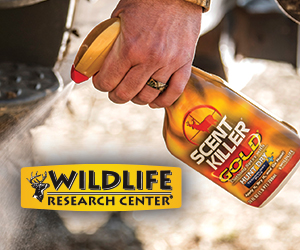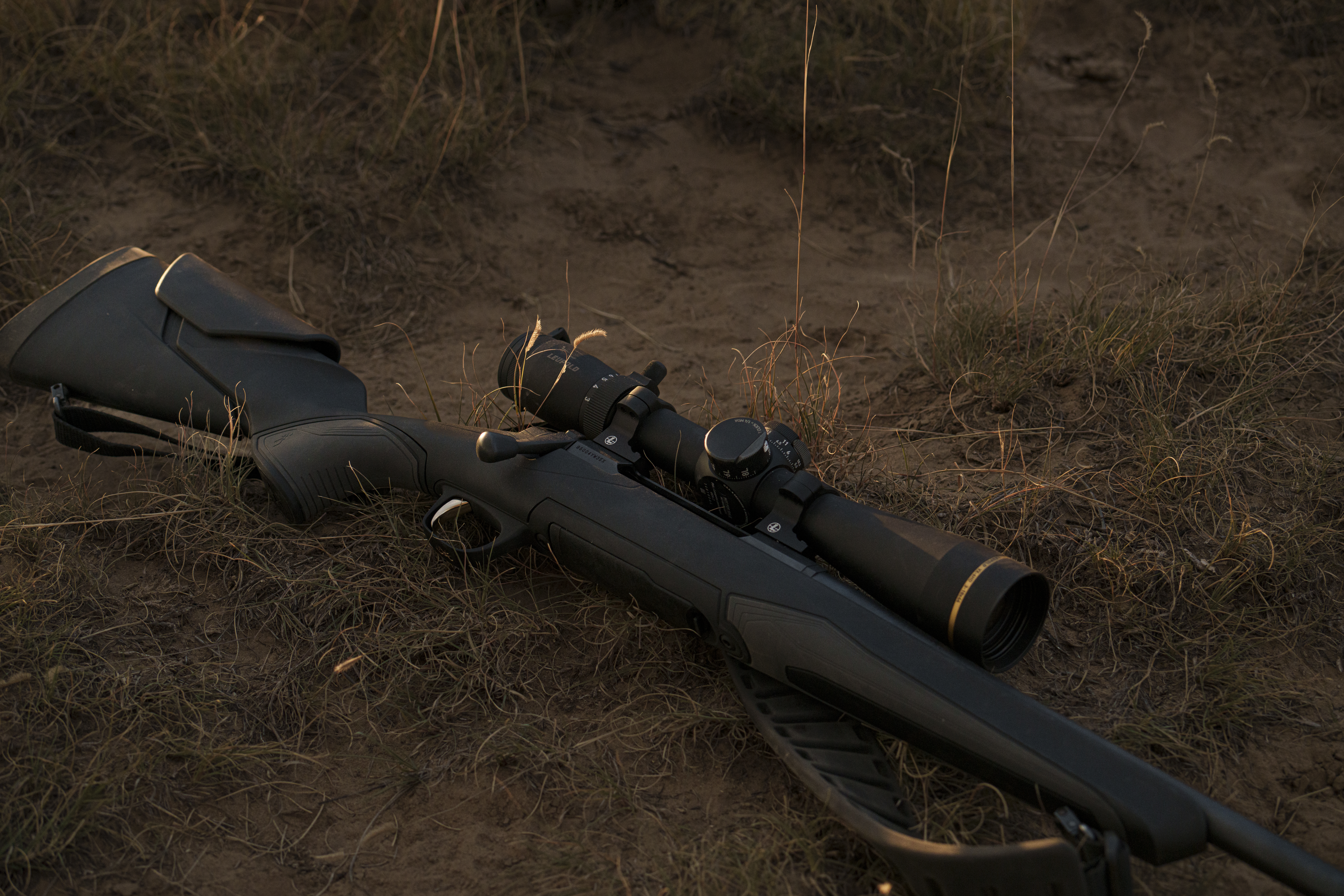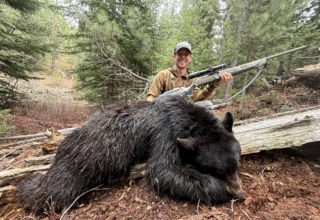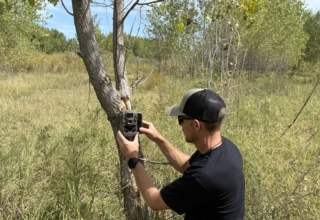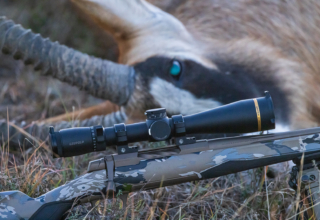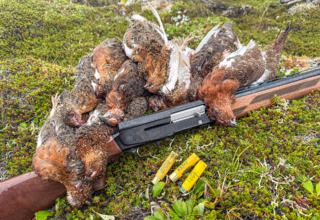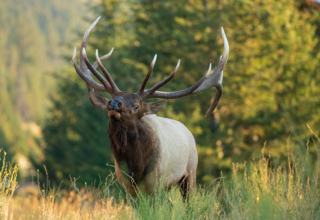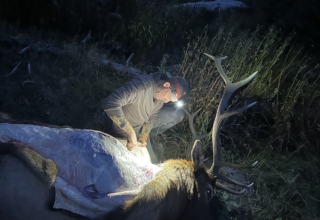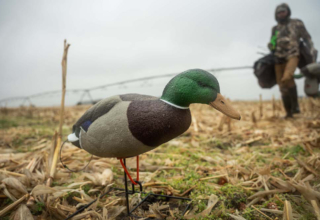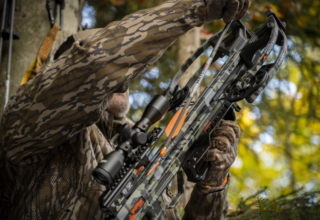Scott Haugen has been on many epic elk hunts over the decades, but has a rifle hunt to thank for what became the best archery elk hunts of his life.
by Scott Haugen
An 18-mile horseback ride found two buddies and me setting up base camp. We were just beneath the 10,000-foot mark in Wyoming’s Absaroka Range, east of Yellowstone National Park.
Old wallows and several rubs confirmed elk had been there. But were they still near? It was November 2001. We held rifle tags. It was our first time hunting the area.
A light skiff of snow fell the first night, making for perfect hunting conditions. The following day seemed promising, but there were no elk, only grizzlies.
Then a snowstorm hit. We were stuck in a tent for the next day and a half. When the storm passed, we emerged to find ourselves—and our horses—standing in over two feet of snow. Given the snow’s rapid accumulation and the dark skies on the horizon, we knew the hunt was over.
Dropping off the mountain was defeating. For years we’d planned this rifle hunt, and now it was coming to an abrupt end. Even our backup spots were laden with snow, making access impossible. A ranger later told us eight feet of snow fell over the next two days, right where we’d camped, and that we escaped in the nick of time.
Both men I hunted with, Tom Buller and Bob Wells, were Wyoming residents, which allowed me to hunt the wilderness with them. Tom and I were boyhood friends but hadn’t seen one another in nearly 30 years. Bob was Tom’s hunting buddy, an exceptional horseman who knew a thing or two about hunting elk. He’s still one of the best elk callers I’ve spent time in the woods with.
On that first hunt, I left Wyoming with a tag in my pocket and bitter memories of how relentless the backcountry can be. But what we’d seen on that trip planted a seed of optimism. The array of rubs and wallows left no question: elk had been there during the rut. An archery hunt was in our future.
Redemption
The following season, I failed to draw a tag. But the year after that, in 2003, I got lucky.
The day we saddled up the string of horses, the thermometer registered 80 degrees, less than ideal elk hunting conditions. Following the 18-mile route to the same campsite was different. This time, we were greeted by blue skies, fresh valleys, and impressive rubs. The aroma of rutting bulls hung heavy in the thin mountain air.
Arriving in camp before the season opener gave us time to scout. The added days weren’t necessary. While we tied off the tent and hoisted food out of grizzly reach, bulls continually bugled all around us. The resonating sounds continued through the nights. Sleep did not come easily.
On opening morning, with the horses fed and watered, we were off before daybreak. Given the threat of grizzlies, we put up a portable electric fence, to keep both the horses in and the grizzlies out. The minute we walked out of camp, we were hunting.
Working our way to the edge of a draw, the first elk we laid eyes on was an impressively broad and heavy 5×5. It came in hot, bugling at every cow call Bob offered. We passed.
Further up the valley, another bull responded to our calls, followed by two more. We’d been hunting less than an hour.
Choosing to cross a deep canyon and hunt the heavy timber on the opposite, north-facing ridge, our efforts were rewarded. Four miles from base camp with no sign of fellow hunters, elk were bugling everywhere.
Wallows were many in every draw. In places, there were more rubbed trees than ones left unscathed. You could almost taste the sweet smell of rutting elk. Trails etched deep into the peat revealed years and years of heavy elk use.
By noon, several bulls had responded to our calls, but seeing them in the thick forest was tough. A raspy bugle resonated from a nearby draw, but the bull wouldn’t budge. I slithered closer, and the moment I saw the colossal 370-class bull, my adrenaline spiked. At 35 yards, I thought it was a done deal. The massive bull flailed in a wallow, covering its body in gray mud, urinating and bugling.
A three-foot-tall pine tree was between us. Some brush on the near side of the wallow blocked my shot. All the bull had to do was stand, step to either side, and it was over. Minutes passed and the bull was still lying down. That’s when I made a mistake. Rather than waiting, I let out a subtle cow call. The massive bull didn’t even raise its head, but a bull standing nearby charged in and stood less than 10 yards from me. I hadn’t seen it in the thick timber.
The 330-inch six-point was nice, but nothing like the giant in the wallow. It busted me, sounding like a locomotive when it turned and ran. The big bull in the wallow instantly tossed back its head and rambled up the adjacent hillside. The wet, ivory-tipped rack glistened, nearly touching the rump patch. It unraveled fast. There was no shot.
Ten minutes later, Bob and I were again set up, calling into a timbered draw. Immediately, a bull bugled back. It was close. I’ll never forget the sound of this brute as it came down the steep mountain, on the run. The chest cavity reverberated with heavy gasps and grunts as the bull made its way down, right at us.
Branches shattered and rocks rolled. The bull came in looking for a fight. Before I could reach full-draw, it was on me, six yards away, its wet, coal-black nose pumping the air. The ears worked hard, twisting and turning like satellite dishes to detect any sound. The eyes were big and rolled back in their sockets. It knew something wasn’t right.
The 340-inch bull bolted. Bob instantly let out a hyper cow call. I reached full draw and vividly remember seeing the tufted top of a young pine tree only a few yards in front of me. Adjusting my hold, I let the arrow fly. The adjustment wasn’t enough.
The broadhead struck the very tip of the little tree and cartwheeled the arrow into the dirt between the bull’s legs. My second bonehead mistake in less than 15 minutes. I was crushed.
We had two hours before heading back to camp. Working our way around the next ridge, we were soon calling. At the sound of Bob’s first cow call, three bulls simultaneously responded. One high on the ridge sounded the most intense.
At first, the bull stood its ground. But seductive cow talk got the best of it, and 10 minutes later, the bull came trotting through the brush, presenting the perfect broadside shot. Bob had a window and took it.
Seconds later, while waiting for Bob’s bull to expire, the sound of raking antlers caught our attention. Glancing around a grove of young pines, the top of a tree whipped with reckless abandon. A cow call further enraged the bull. It closed the 50-yard gap in quick order. I was anchored, solid and calm. At 23 yards, the shot was simple.
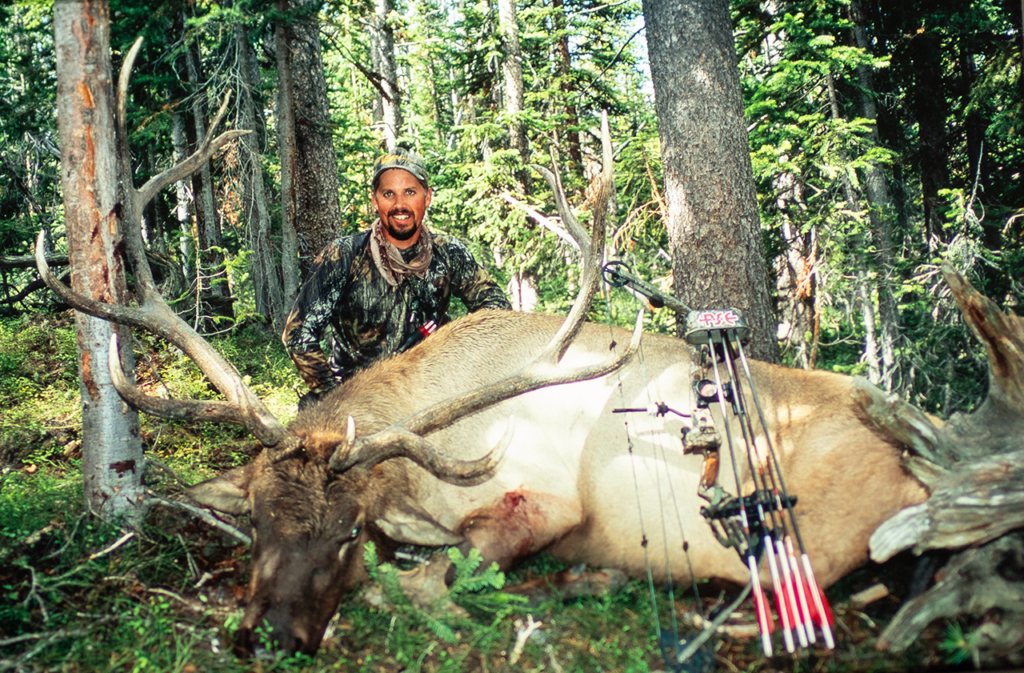
With two bulls down, the work began. We quickly cut up my bull and got all the meat hanging in trees, out of reach from bears.
To Get More Archery Elk Hunting Tips, CLICK HERE!
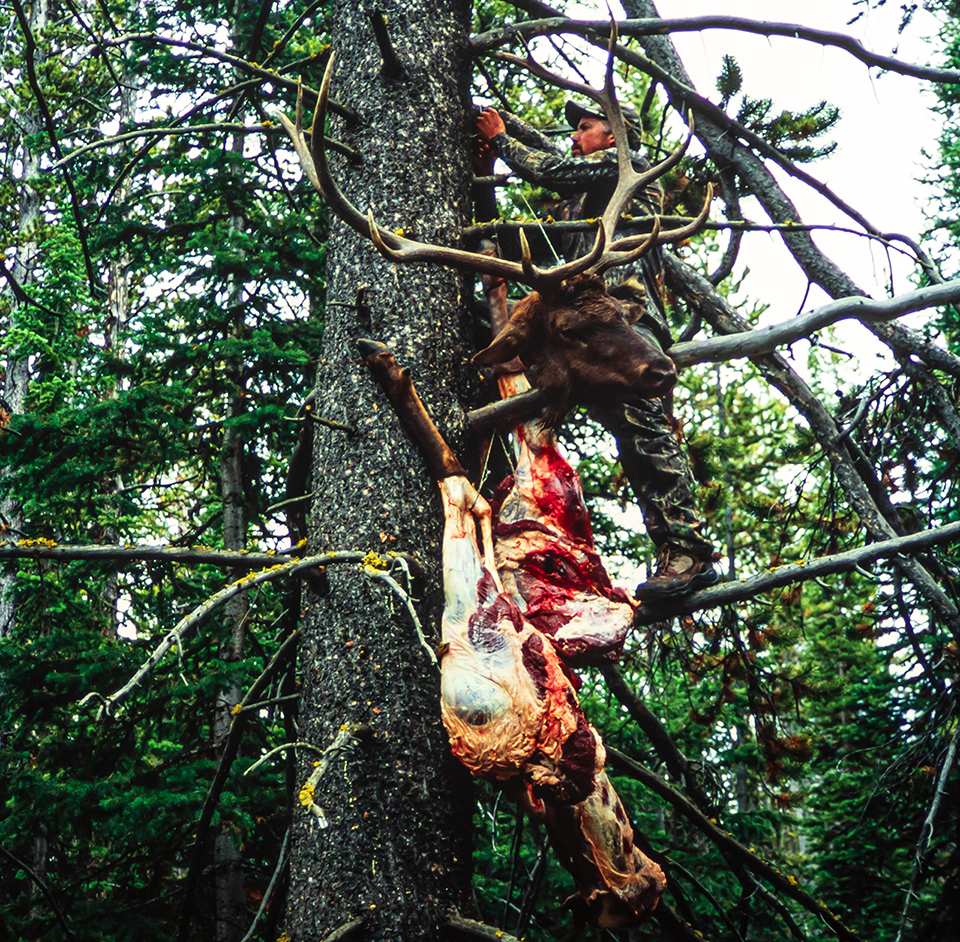
Moving to Bob’s bull, we were snapping a few photos when a lone bull bugled below us. Another bull in the timber above answered. Bob responded with his bugle, and the two bulls fired right back. A quick cow call triggered another response. Tom barely had time to grab his bow and get into position.
Sprinting into a small clearing, Tom hadn’t been there a minute when the bull from above arrived. It struck an aggressive posture when it hit the open. The bull was seeking battle. Its massive, wide-sweeping rack shocked all of us. At 16 yards, Tom’s shot was perfect. The big seven-point went down after a quick 40-yard death sprint.
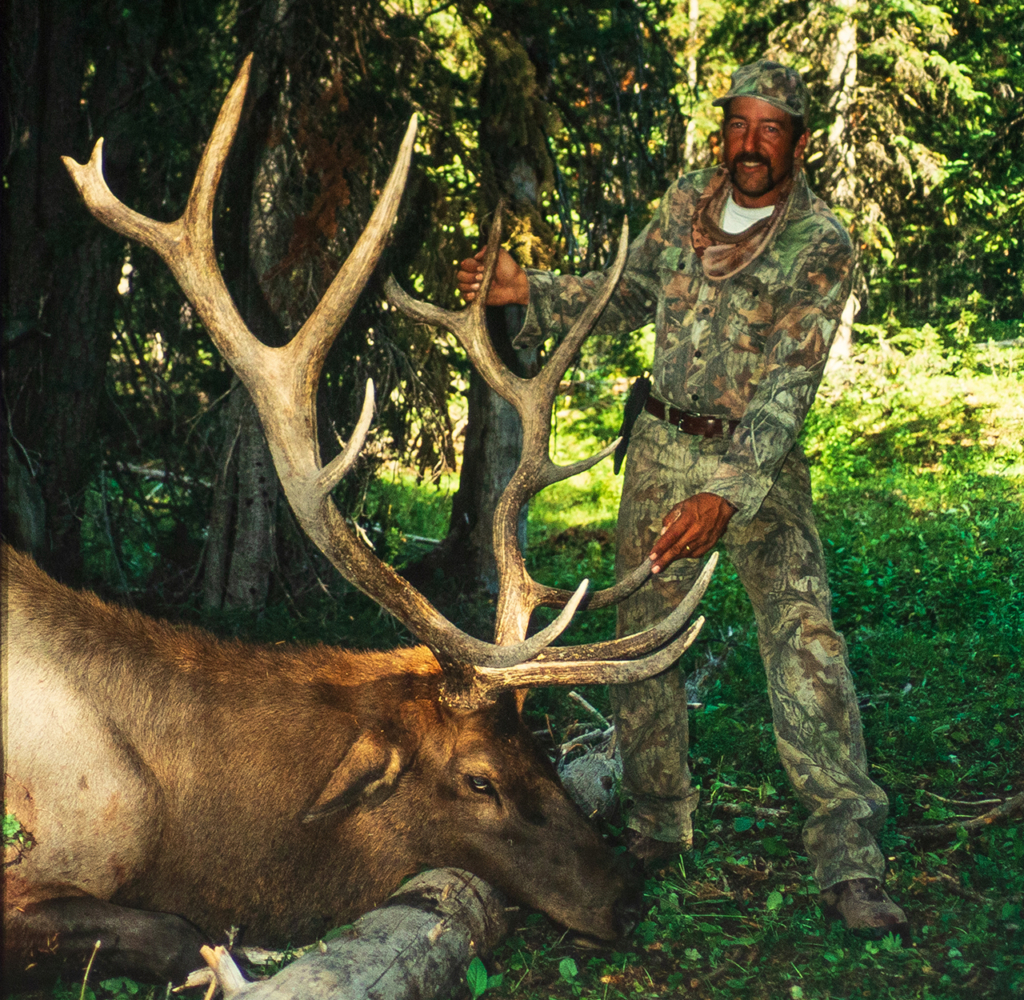
The following morning, we walked the horses within 300 yards of the kills. On our last trip to pack meat for the horses, we each carried the heads and capes of our bulls. Passing by a small waterfall, we paused, drank from our filtered water bottles, showered, and prepared for the several hours of hiking ahead.
We were able to load our packstring with all three bulls and camp. Heading out of the hills was a good feeling; Much better than two years prior.
Total, we covered 58 miles—22 on horseback, 36 on foot. While the do-it-yourself wilderness adventure was demanding and painful, it was one of the most rewarding hunts of our lives. Staggering to the trailhead, we unsaddled the packstring and guzzled water. We vowed there would be a next time, and there was, one year later.
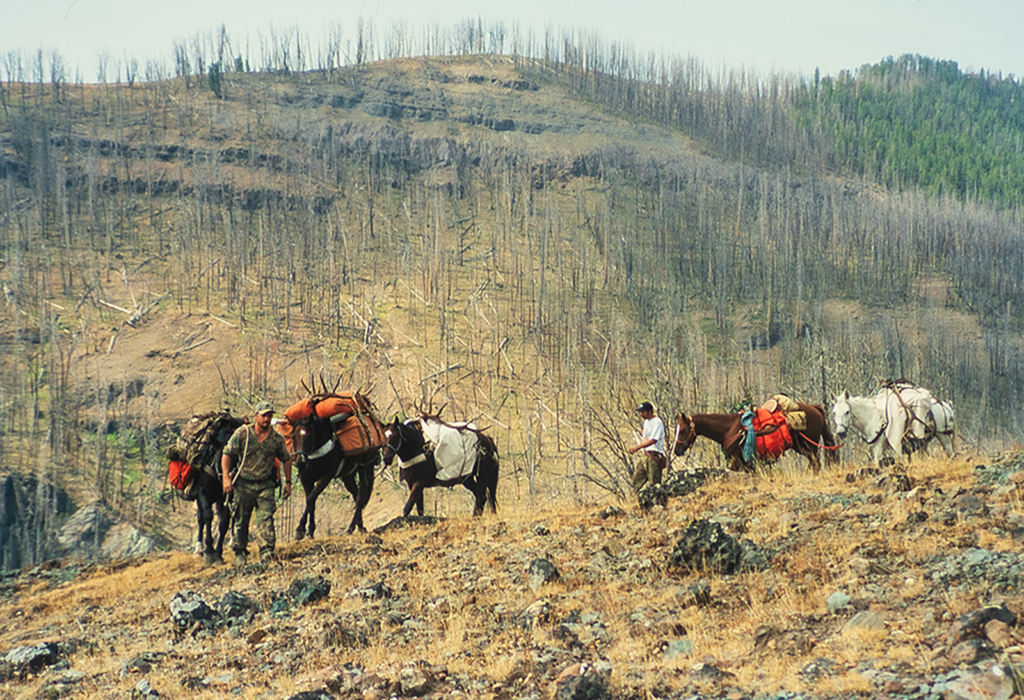
The Return
On the September 2004 archery opener, we were back in our beloved camping spot. This year, however, bulls didn’t keep us up at night. We didn’t hear any bugles, not even in the prime hours of opening morning. We decided to saddle the horses and head across a prominent ridge toward the edge of an old burn.
That’s when Tom’s horse went berserk. It kicked, sprinted, and bucked down the trail, slamming Tom to the ground. Had Tom not broken his fall into a boulder patch, the outcome could have been much worse than a sore, scraped jaw and bruised arms.
The horse went barreling down a steep hill at breakneck speed, hurdling and busting through blowdowns. The power and speed of the horse were mind-boggling. After a quarter-mile sprint, the horse buckled beneath a jumble of blown-down trees, landing tight against a stack of upended root wads. The saddle and panniers ended up under the horse’s belly. Tom’s bow was demolished.
Leading your packstring into the rugged backcountry can be the most dangerous part of a do-it-yourself hunt. Sore and without a bow, Tom headed back to camp to nurse his wounds. Bob and I continued.
Working down the south-facing slope of a big, burned ridge, we finally heard the first bugle. Bob responded with a cow call, and the bull fired right back. At 90 yards, the six-point emerged from a brushy thicket and stood in a small opening of green grass, bugling amid the lifeless, burned trees surrounding it. It wasn’t a big bull. We kept moving.
Continuing across the burn, into the bottom of the canyon, and up the other side, we finally arrived in the lush timber we knew held bulls. But the first setup didn’t elicit a single bugle. Moving 200 yards to the west, into the next creek bottom, fresh droppings, rubs, and a well-used wallow left no doubt bulls were near.
Bob delivered a cow call, and I followed with calf sounds. Immediately, a bull fired back. Within seconds, its wide rack could be seen swaying through the trees.
For the first 75 yards, the bull was in no hurry. At 60 yards, it paused behind a tree. Bob and I teamed up, throwing out several multi-directional cow and calf calls. The goal was to sound like a herd on the move. It worked.
At 40 yards, the bull walked through an opening, and Bob stopped it with a quick call. Bob’s arrow flew over the bull’s back. It sprinted away. But in the world of hunting rut-crazed bulls, it’s never over. Immediately, Bob cut loose with loud, aggressive cow calls. The bull stopped behind some thick brush. A few more calls, and it circled back in. Bob’s 32-yard shot found the mark.
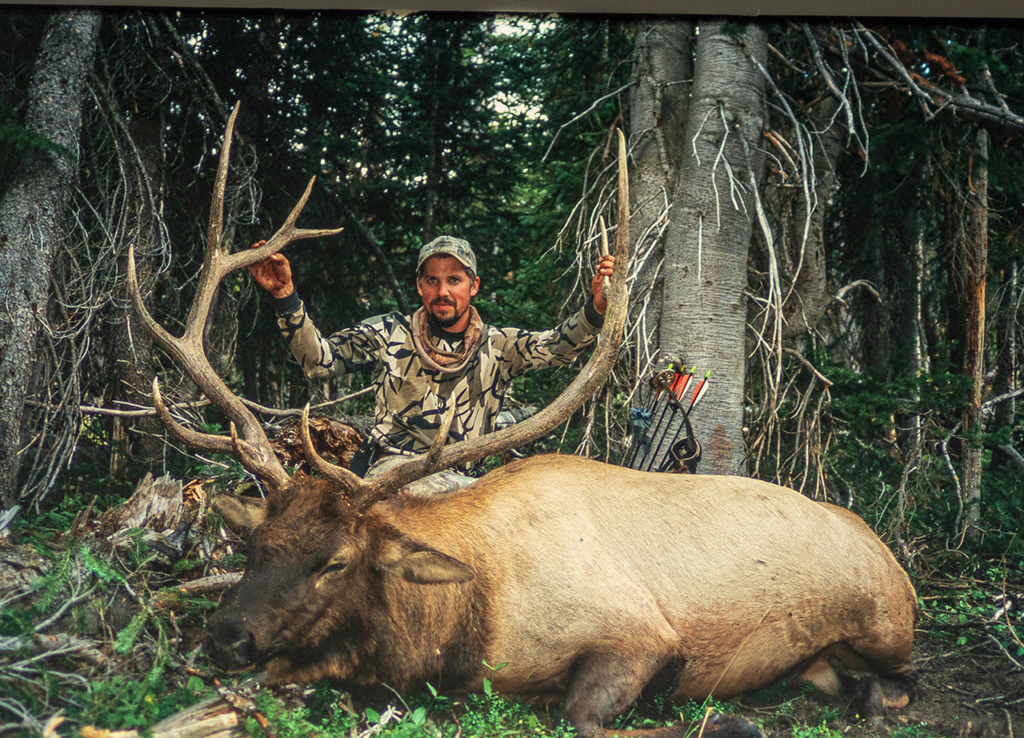
We quartered the bull and hung the meat along with the 6×6 rack, high in the trees. We’d return the following day with horses to pack out the meat. We still had six hours of daylight left.
Over the next two hours, we talked to more than a dozen bulls. Over half were coming to our calls, only to bust us due to the unrelenting, swirling winds. Hoping to escape the wind, we dropped into a deep, wooded draw.
Losing elevation wasn’t an easy decision, as we were walking the horses, not riding them. We weren’t quite to where we wanted to be when a bull, bugling above us, got our attention. We hadn’t made a sound, but the bull was incessantly bugling. The wind was still swirling as we made a move, hoping it would level out by the time we reached the bull.
We’d tied off the horses and climbed 500 feet up the mountain. Bob cow called. Not only did the bull respond, but two other bulls also fired back. The wind swirled harder with each passing moment. We knew what the outcome would be. Rather than force it, we waited. We didn’t move for two hours, willing the wind to let up. It didn’t.
We decided to press our luck, but one bull busted us. It was game over. Miles into the backcountry, surrounded by big bulls, the wind gave us fits. It wasn’t worth the risk of educating more bulls, so we decided to head back to camp and return in the morning, hopefully in calm conditions.
We hadn’t gone 250 yards when a bull let out a bugle that cut through the 25-mile-per-hour winds. We were on the very edge of the timber. The surrounding trees whipping with fury in the blustery winds.
The forest was noisy, masking our sound as we quickly moved to within 75 yards of where we thought the bull was. Bob delivered a single cow call. Before the call was lost in the wind, the bull hammered back with a double bugle and a long, raspy chuckle.
Over the next five minutes, the bull answered our calls two more times, then went silent. Confident the bull was slowly approaching with caution, my most significant concern was that it would circle behind us, trying to catch our wind.
Ten more minutes passed with no response. Then, movement from where the bull had been calling caught my eye. At first, it was hard to decipher amid the flailing limbs. Then, rays of sunlight slashing through the dark timber were broken by a massive set of antlers moving our way. The rangefinder gave a firm reading of 40 yards to the trail on which the bull was moving.
Taking a deep breath, the sounds of howling winds and crashing branches were blocked from my mind as I effortlessly reached full draw. When the bull hit the mark, my 40-yard pin was centered behind the left shoulder. The 100-grain broadhead cut through both lungs, dropping the bull on its third lunge, nine yards from where it was hit.
It was the fastest I’d ever seen a bull expire. Later inspection found the arrow protruding from the back right hip of the bull. It was a fantastic testimony as to how tough a well-built arrow is. When I shot the bull, it was broadside. The arrow hit the mark, pierced both lungs, then took a 90-degree turn, punched through the diaphragm, liver, and then nearly exited above the opposite hip joint. That explained why the bull dropped so quickly.
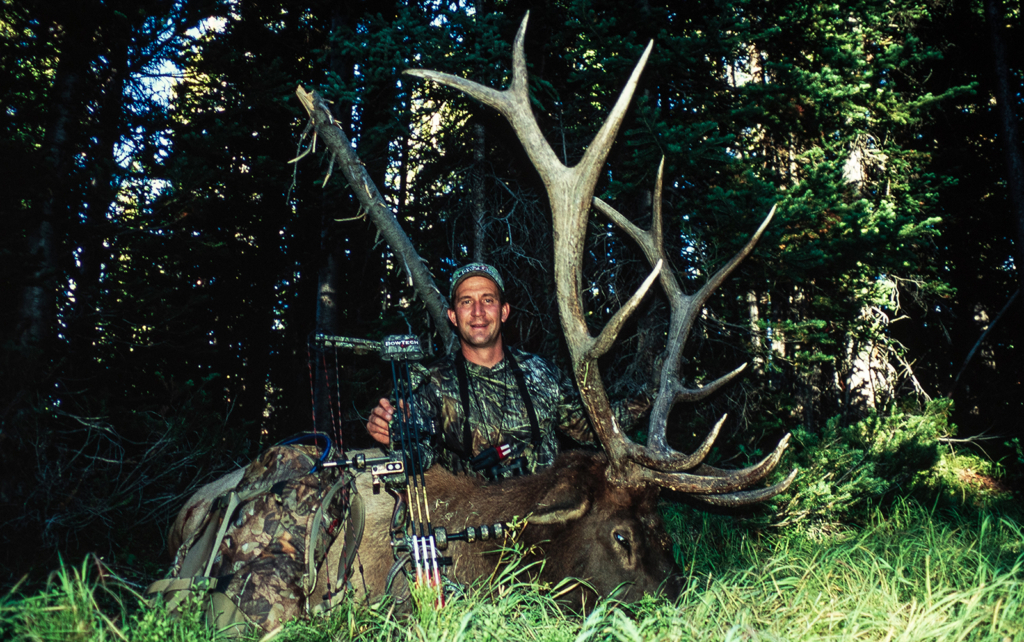
The labor-intensive butchering and arduous four-mile hike back to camp was taxing. Adrenaline helped ease the pain. That night, seven inches of snow fell. With Tom’s bow out of commission and his shoulder not working like it should, we agreed it was best to get off the mountain.
Though brief, it was a physically demanding and mentally draining hunt; one filled with many emotional highs and lows. Tom’s bow getting destroyed was a bad deal, but not nearly as tragic as the outcome could have been.
Good friends, challenging country, and big bulls, that’s what this wilderness elk hunt was all about. A few years later, Bob returned to hunt the place with his wife. He didn’t see a single elk, not even a track. Wolves had decimated the herd and run them out. Looking back, we were fortunate to experience the hunts we did.

